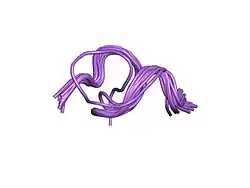| RPLP2 | |||||||||||||||||||||||||||||||||||||||||||||||||||
|---|---|---|---|---|---|---|---|---|---|---|---|---|---|---|---|---|---|---|---|---|---|---|---|---|---|---|---|---|---|---|---|---|---|---|---|---|---|---|---|---|---|---|---|---|---|---|---|---|---|---|---|
 | |||||||||||||||||||||||||||||||||||||||||||||||||||
| |||||||||||||||||||||||||||||||||||||||||||||||||||
| Identifiers | |||||||||||||||||||||||||||||||||||||||||||||||||||
| Aliases | RPLP2, D11S2243E, LP2, P2, RPP2, ribosomal protein lateral stalk subunit P2 | ||||||||||||||||||||||||||||||||||||||||||||||||||
| External IDs | OMIM: 180530 MGI: 1914436 HomoloGene: 133574 GeneCards: RPLP2 | ||||||||||||||||||||||||||||||||||||||||||||||||||
| |||||||||||||||||||||||||||||||||||||||||||||||||||
| |||||||||||||||||||||||||||||||||||||||||||||||||||
| |||||||||||||||||||||||||||||||||||||||||||||||||||
| |||||||||||||||||||||||||||||||||||||||||||||||||||
| Wikidata | |||||||||||||||||||||||||||||||||||||||||||||||||||
| |||||||||||||||||||||||||||||||||||||||||||||||||||
60S acidic ribosomal protein P2 is a protein that in humans is encoded by the RPLP2 gene.[4][5]
Ribosomes, the organelles that catalyze protein synthesis, consist of a small 40S subunit and a large 60S subunit. Together these subunits are composed of 4 RNA species and approximately 80 structurally distinct proteins. This gene encodes a ribosomal phosphoprotein that is a component of the 60S subunit. The protein, which is a functional equivalent of the Escherichia coli L7/L12 ribosomal protein, belongs to the L12P family of ribosomal proteins. It plays an important role in the elongation step of protein synthesis. Unlike most ribosomal proteins, which are basic, the encoded protein is acidic. Its C-terminal end is nearly identical to the C-terminal ends of the ribosomal phosphoproteins P0 and P1. The P2 protein can interact with P0 and P1 to form a pentameric complex consisting of P1 and P2 dimers, and a P0 monomer. The protein is located in the cytoplasm. As is typical for genes encoding ribosomal proteins, there are multiple processed pseudogenes of this gene dispersed through the genome.[5]
Interactions
References
- 1 2 3 GRCh38: Ensembl release 89: ENSG00000177600 - Ensembl, May 2017
- ↑ "Human PubMed Reference:". National Center for Biotechnology Information, U.S. National Library of Medicine.
- ↑ "Mouse PubMed Reference:". National Center for Biotechnology Information, U.S. National Library of Medicine.
- ↑ Rich BE, Steitz JA (March 1988). "Human acidic ribosomal phosphoproteins P0, P1, and P2: analysis of cDNA clones, in vitro synthesis, and assembly". Mol Cell Biol. 7 (11): 4065–74. doi:10.1128/mcb.7.11.4065. PMC 368077. PMID 3323886.
- 1 2 "Entrez Gene: RPLP2 ribosomal protein, large, P2".
- ↑ Tchórzewski, M; Boldyreff B; Issinger O G; Grankowski N (July 2000). "Analysis of the protein-protein interactions between the human acidic ribosomal P-proteins: evaluation by the two hybrid system". Int. J. Biochem. Cell Biol. England. 32 (7): 737–746. doi:10.1016/S1357-2725(00)00017-0. PMID 10856704.
Further reading
- Wool IG; Chan YL; Glück A (1996). "Structure and evolution of mammalian ribosomal proteins". Biochem. Cell Biol. 73 (11–12): 933–947. doi:10.1139/o95-101. PMID 8722009.
- Hochstrasser DF, Frutiger S, Paquet N, et al. (1993). "Human liver protein map: a reference database established by microsequencing and gel comparison". Electrophoresis. 13 (12): 992–1001. doi:10.1002/elps.11501301201. PMID 1286669. S2CID 23518983.
- Sharp MG, Adams SM, Elvin P, et al. (1990). "A sequence previously identified as metastasis-related encodes an acidic ribosomal phosphoprotein, P2". Br. J. Cancer. 61 (1): 83–8. doi:10.1038/bjc.1990.19. PMC 1971331. PMID 2153399.
- Kato S, Sekine S, Oh SW, et al. (1995). "Construction of a human full-length cDNA bank". Gene. 150 (2): 243–250. doi:10.1016/0378-1119(94)90433-2. PMID 7821789.
- Matoba R, Okubo K, Hori N, et al. (1994). "The addition of 5'-coding information to a 3'-directed cDNA library improves analysis of gene expression". Gene. 146 (2): 199–207. doi:10.1016/0378-1119(94)90293-3. PMID 8076819.
- Scanlan MJ, Gordan JD, Williamson B, et al. (1999). "Antigens recognized by autologous antibody in patients with renal-cell carcinoma". Int. J. Cancer. 83 (4): 456–464. doi:10.1002/(SICI)1097-0215(19991112)83:4<456::AID-IJC4>3.0.CO;2-5. PMID 10508479.
- Tchórzewski M, Boldyreff B, Issinger O, Grankowski N (2000). "Analysis of the protein-protein interactions between the human acidic ribosomal P-proteins: evaluation by the two hybrid system". Int. J. Biochem. Cell Biol. 32 (7): 737–746. doi:10.1016/S1357-2725(00)00017-0. PMID 10856704.
- Uechi T, Tanaka T, Kenmochi N (2001). "A complete map of the human ribosomal protein genes: assignment of 80 genes to the cytogenetic map and implications for human disorders". Genomics. 72 (3): 223–230. doi:10.1006/geno.2000.6470. PMID 11401437.
- Yoshihama M, Uechi T, Asakawa S, et al. (2002). "The human ribosomal protein genes: sequencing and comparative analysis of 73 genes". Genome Res. 12 (3): 379–390. doi:10.1101/gr.214202. PMC 155282. PMID 11875025.
- Freeman JL, Gonzalo P, Pitcher JA, et al. (2002). "Beta 2-adrenergic receptor stimulated, G protein-coupled receptor kinase 2 mediated, phosphorylation of ribosomal protein P2". Biochemistry. 41 (42): 12850–12857. doi:10.1021/bi020145d. PMID 12379128.
- Strausberg RL, Feingold EA, Grouse LH, et al. (2003). "Generation and initial analysis of more than 15,000 full-length human and mouse cDNA sequences". Proc. Natl. Acad. Sci. U.S.A. 99 (26): 16899–16903. Bibcode:2002PNAS...9916899M. doi:10.1073/pnas.242603899. PMC 139241. PMID 12477932.
- Tchórzewski M, Krokowski D, Rzeski W, et al. (2003). "The subcellular distribution of the human ribosomal "stalk" components: P1, P2 and P0 proteins". Int. J. Biochem. Cell Biol. 35 (2): 203–211. doi:10.1016/S1357-2725(02)00133-4. PMID 12479870.
- Shu H, Chen S, Bi Q, et al. (2004). "Identification of phosphoproteins and their phosphorylation sites in the WEHI-231 B lymphoma cell line". Mol. Cell. Proteomics. 3 (3): 279–286. doi:10.1074/mcp.D300003-MCP200. PMID 14729942.
- Gardner-Thorpe J, Ito H, Ashley SW, Whang EE (2004). "Ribosomal protein P2: a potential molecular target for antisense therapy of human malignancies". Anticancer Res. 23 (6C): 4549–60. PMID 14981896.
- Giorgianni F, Beranova-Giorgianni S, Desiderio DM (2004). "Identification and characterization of phosphorylated proteins in the human pituitary". Proteomics. 4 (3): 587–598. doi:10.1002/pmic.200300584. PMID 14997482. S2CID 25355914.
- Brandenberger R, Wei H, Zhang S, et al. (2005). "Transcriptome characterization elucidates signaling networks that control human ES cell growth and differentiation". Nat. Biotechnol. 22 (6): 707–716. doi:10.1038/nbt971. PMID 15146197. S2CID 27764390.
- Gerhard DS, Wagner L, Feingold EA, et al. (2004). "The status, quality, and expansion of the NIH full-length cDNA project: the Mammalian Gene Collection (MGC)". Genome Res. 14 (10B): 2121–2127. doi:10.1101/gr.2596504. PMC 528928. PMID 15489334.
- Andersen JS, Lam YW, Leung AK, et al. (2005). "Nucleolar proteome dynamics". Nature. 433 (7021): 77–83. Bibcode:2005Natur.433...77A. doi:10.1038/nature03207. PMID 15635413. S2CID 4344740.


